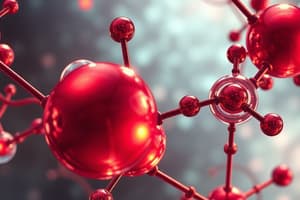Podcast
Questions and Answers
What is the charge of protons?
What is the charge of protons?
- Negative charge
- Positive charge (correct)
- Neutral charge
- No charge
What is the main function of electrons in an atom?
What is the main function of electrons in an atom?
- Neutralizing the charge of the nucleus
- Providing stability to the nucleus
- Creating bonds with other atoms (correct)
- Determining the identity of an element
In chemical bonding, what happens in a covalent bond?
In chemical bonding, what happens in a covalent bond?
- Neutral atom sharing electrons with metals
- Nonmetallic atoms sharing electrons (correct)
- Metal atoms sharing electron clouds
- Electron transfer between metals and nonmetals
What determines the identity of an element?
What determines the identity of an element?
What is a chemical reaction?
What is a chemical reaction?
Which type of bond involves electron sharing between metal and nonmetal atoms?
Which type of bond involves electron sharing between metal and nonmetal atoms?
What is the definition of matter?
What is the definition of matter?
When you convert matches into fire, what type of transformation is taking place?
When you convert matches into fire, what type of transformation is taking place?
Which field of chemistry focuses on the smallest units of elements that retain all the characteristics of the element itself?
Which field of chemistry focuses on the smallest units of elements that retain all the characteristics of the element itself?
What connects concepts from fields like physics, biology, geology, and astronomy to chemistry?
What connects concepts from fields like physics, biology, geology, and astronomy to chemistry?
What is the ability to do work called?
What is the ability to do work called?
When you mix sand and water to create glass, what kind of transformation is happening?
When you mix sand and water to create glass, what kind of transformation is happening?
Flashcards are hidden until you start studying
Study Notes
Chemistry
Chemistry is often referred to as "the central science," as it connects concepts from many other fields such as physics, biology, geology, astronomy, and more. At its core, chemistry deals with matter—what things are made of, why they have their properties, how they interact, change, and react under different conditions. This broad discipline can be broken down into various subfields, each with specific areas of focus, including physical chemistry, organic chemistry, analytical chemistry, and others. Here, we'll explore some fundamental aspects of this fascinating subject, starting with an introduction to atoms and molecules, moving on to the principles of chemical bonding, and finally discussing chemical reactions.
Matter and Energy
Matter refers to anything that has mass and takes up space, while energy is the ability to do work. In a nutshell, everything around us consists of either matter or energy, although these two entities are distinctly different. For example, when you light a match, you convert matches (matter) into fire (a form of energy), producing heat and light. Conversely, if you mix sand and water together, you create glass, which represents a transformation of matter. These transformations involve exchanges between matter and energy, forming the basis of much of what chemists study.
Atomic Structure
Atoms are the smallest units of elements that retain all the characteristics of the element itself. They consist of three main parts: protons, neutrons, and electrons. Protons have a positive charge (+1), neutrons are neutral (no charge), and electrons carry a negative charge (-1). A nucleus containing both protons and neutrons lies at the center of every atom, surrounded by orbital shells where electrons orbit the nucleus like planets revolving around the sun. The number of protons determines the identity of an element; hydrogen has one proton, helium has two, lithium three, and so forth, giving rise to the periodic table.
Chemical Bonding
The forces holding atoms together in compounds are called chemical bonds. There are four major types of bonds: covalent bonds, ionic bonds, metal-nonmetal bonds, and metallic bonds. Covalent bonds occur when nonmetallic atoms share electrons, ionic bonds result from the transfer of electrons between metals and nonmetals, metal-nonmetal bonds involve electron sharing, and metallic bonds arise through shared electron clouds among metal atoms. Understanding chemical bonding helps explain the formation of substances such as sugar, salt, water, oil, and even living organisms themselves.
Chemical Reactions
A chemical reaction occurs when the atoms of one substance rearrange to form new substances with different combinations of atoms. In simpler terms, it's a process where one thing changes into another, creating something completely new. Examples abound - burning wood creates ash, cooking eggs produces omelets, and rust forms when iron reacts with oxygen. Each type of chemical reaction involves a unique set of steps and pathways leading to different products, making them essential tools in understanding everyday events.
In summary, chemistry explores the nature of the world around us, providing insights into basic building blocks (atoms), interactions between those building blocks (chemical bonds), and the processes by which everything evolves (reactions). It bridges gaps between seemingly unrelated disciplines, offering a comprehensive view of our universe that goes beyond the realm of 'what it looks like'. Instead, chemistry tells us 'how it works', painting a picture of reality based on scientific evidence rather than personal experiences alone.
Studying That Suits You
Use AI to generate personalized quizzes and flashcards to suit your learning preferences.




